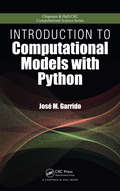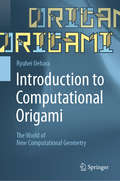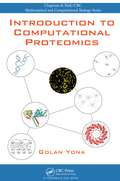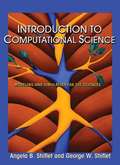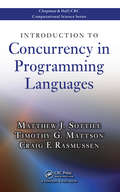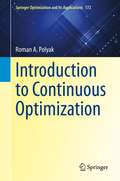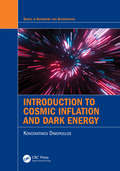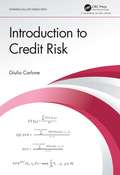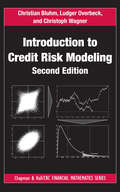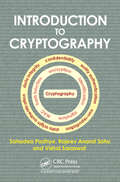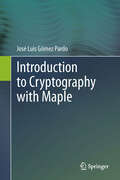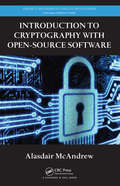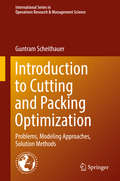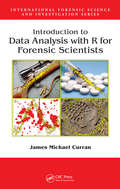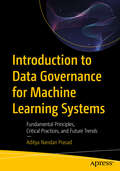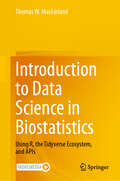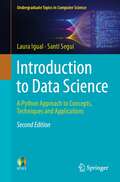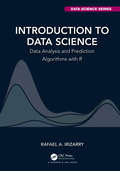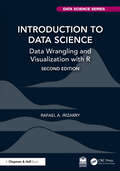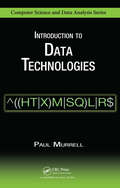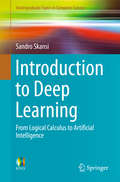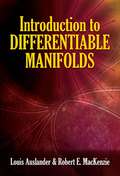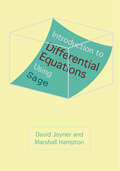- Table View
- List View
Introduction to Computational Models with Python (Chapman & Hall/CRC Computational Science)
by Jose M. GarridoIntroduction to Computational Models with Python explains how to implement computational models using the flexible and easy-to-use Python programming language. The book uses the Python programming language interpreter and several packages from the huge Python Library that improve the performance of numerical computing, such as the Numpy and Scipy m
Introduction to Computational Origami: The World of New Computational Geometry
by Ryuhei UeharaThis book focuses on origami from the point of view of computer science. Ranging from basic theorems to the latest research results, the book introduces the considerably new and fertile research field of computational origami as computer science. Part I introduces basic knowledge of the geometry of development, also called a net, of a solid. Part II further details the topic of nets. In the science of nets, there are numerous unresolved issues, and mathematical characterization and the development of efficient algorithms by computer are closely connected with each other. Part III discusses folding models and their computational complexity. When a folding model is fixed, to find efficient ways of folding is to propose efficient algorithms. If this is difficult, it is intractable in terms of computational complexity. This is, precisely, an area for computer science research. Part IV presents some of the latest research topics as advanced problems. Commentaries on all exercises included in the last chapter. The contents are organized in a self-contained way, and no previous knowledge is required. This book is suitable for undergraduate, graduate, and even high school students, as well as researchers and engineers interested in origami.
Introduction to Computational Proteomics
by Golan YonaIntroduction to Computational Proteomics introduces the field of computational biology through a focused approach that tackles the different steps and problems involved with protein analysis, classification, and meta-organization. The book starts with the analysis of individual entities and works its way through the analysis of more complex entitie
Introduction to Computational Science
by Angela B. ShifletComputational science is a quickly emerging field at the intersection of the sciences, computer science, and mathematics because much scientific investigation now involves computing as well as theory and experiment. However, limited educational materials exist in this field. Introduction to Computational Science fills this void with a flexible, readable textbook that assumes only a background in high school algebra and enables instructors to follow tailored pathways through the material. It is the first textbook designed specifically for an introductory course in the computational science and engineering curriculum. The text embraces two major approaches to computational science problems: System dynamics models with their global views of major systems that change with time; and cellular automaton simulations with their local views of how individuals affect individuals. While the text is generic, an extensive author-generated Web-site contains tutorials and files in a variety of software packages to accompany the text.Generic software approach in the text Web site with tutorials and files in a variety of software packages Engaging examples, exercises, and projects that explore science Additional, substantial projects for students to develop individually or in teams Consistent application of the modeling process Quick review questions and answers Projects for students to develop individually or in teams Reference sections for most modules, as well as a glossary Online instructor's manual with a test bank and solutions
Introduction to Concurrency in Programming Languages
by Matthew J. Sottile Timothy G. Mattson Craig E RasmussenIllustrating the effect of concurrency on programs written in familiar languages, this text focuses on novel language abstractions that truly bring concurrency into the language and aid analysis and compilation tools in generating efficient, correct programs. It also explains the complexity involved in taking advantage of concurrency with regard to program correctness and performance. The book describes the historical development of current programming languages and the common threads that exist among them. It also contains several chapters on design patterns for parallel programming and includes quick reference guides to OpenMP, Erlang, and Cilk. Ancillary materials are available on the book's website.
Introduction to Continuous Optimization (Springer Optimization and Its Applications #172)
by Roman A. PolyakThis self-contained monograph presents the reader with an authoritative view of Continuous Optimization, an area of mathematical optimization that has experienced major developments during the past 40 years. The book contains results which have not yet been covered in a systematic way as well as a summary of results on NR theory and methods developed over the last several decades. The readership is aimed to graduate students in applied mathematics, computer science, economics, as well as researchers working in optimization and those applying optimization methods for solving real life problems. Sufficient exercises throughout provide graduate students and instructors with practical utility in a two-semester course in Continuous Optimization.The topical coverage includes interior point methods, self-concordance theory and related complexity issues, first and second order methods with accelerated convergence, nonlinear rescaling (NR) theory and exterior point methods, just to mention a few. The book contains a unified approach to both interior and exterior point methods with emphasis of the crucial duality role. One of the main achievements of the book shows what makes the exterior point methods numerically attractive and why. The book is composed in five parts. The first part contains the basics of calculus, convex analysis, elements of unconstrained optimization, as well as classical results of linear and convex optimization. The second part contains the basics of self-concordance theory and interior point methods, including complexity results for LP, QP, and QP with quadratic constraint, semidefinite and conic programming. In the third part, the NR and Lagrangian transformation theories are considered and exterior point methods are described. Three important problems in finding equilibrium are considered in the fourth part. In the fifth and final part of the book, several important applications arising in economics, structural optimization, medicine, statistical learning theory, and more, are detailed. Numerical results, obtained by solving a number of real life and test problems, are also provided.
Introduction to Cosmic Inflation and Dark Energy (ISSN)
by Konstantinos DimopoulosCosmic inflation and dark energy hold the key to the origin and the eventual fate of the Universe. Despite the increasing prominence of these subjects in research and teaching over the past decade or more, no introductory textbook dedicated to these topics has been previously published. Dr. Konstantinos Dimopoulos is a highly regarded expert in the field, and an experienced communicator of the subject to students. In this book, he provides advanced undergraduate and early graduate students with an accessible introduction and equips them with the tools they need to understand the cosmology of cosmic inflation and dark energy.Features: Provides a concise, pedagogical "crash course" in big bang cosmology, focusing on the dynamics and the history of the Universe, with an emphasis on the role of dark energy Chapters contain questions and problems for readers to test their understanding The first book to make cosmic inflation and dark energy accessible to students
Introduction to Cosmology
by Barbara RydenThis second edition of Introduction to Cosmology is an exciting update of an award-winning textbook. It is aimed primarily at advanced undergraduate students in physics and astronomy, but is also useful as a supplementary text at higher levels. It explains modern cosmological concepts, such as dark energy, in the context of the Big Bang theory. Its clear, lucid writing style, with a wealth of useful everyday analogies, makes it exceptionally engaging. Emphasis is placed on the links between theoretical concepts of cosmology and the observable properties of the universe, building deeper physical insights in the reader. The second edition includes recent observational results, fuller descriptions of special and general relativity, expanded discussions of dark energy, and a new chapter on baryonic matter that makes up stars and galaxies. It is an ideal textbook for the era of precision cosmology in the accelerating universe. Written in an engaging style, using clear explanations and analogies to help students connect cosmology to everyday life Fits well to introductory cosmology courses, without requiring advanced mathematics or any prior study of astronomy Includes creative end-of-chapter problems that have been class-tested on students, with an instructor's manual featuring solutions available via www.cambridge.org/cosmology
Introduction to Credit Risk
by Giulio CarloneIntroduction to Credit Risk focuses on analysis of credit risk, derivatives, equity investments, portfolio management, quantitative methods, and risk management. In terms of application, this book can be used as an important tool to explain how to generate data rows of expected exposure to counterparty credit risk. The book also directs the reader on how to visualize, in real time, the results of this data, generated with a Java tool. Features Uses an in-depth case study to illustrate multiple factors in counterparty credit risk exposures Suitable for quantitative risk managers at banks, as well as students of finance, financial mathematics, and software engineering Provides the reader with numerous examples and applications Giulio Carlone has an MBA, a PhD, and a Master’s degree in Computer Science from the University of Italy. He is a member of the software system engineering staff of the Department of Computer Science at University College London. He has 20 years of practical experience in technical software engineering and quantitative finance engineering in the commercial sector. His research interests include the use of communication strategies and the implementation of plans and projects using financial software for requirement specifications, requirements analysis, and architectural design.
Introduction to Credit Risk Modeling (Chapman and Hall/CRC Financial Mathematics Series)
by Ludger Overbeck Christoph Wagner Christian BluhmContains Nearly 100 Pages of New MaterialThe recent financial crisis has shown that credit risk in particular and finance in general remain important fields for the application of mathematical concepts to real-life situations. While continuing to focus on common mathematical approaches to model credit portfolios, Introduction to Credit Risk Modelin
Introduction to Cryptography
by Vishal Saraswat Sahadeo Padhye Rajeev A. SahuElectronic communication and financial transactions have assumed massive proportions today. But they come with high risks. Achieving cyber security has become a top priority, and has become one of the most crucial areas of study and research in IT. This book introduces readers to perhaps the most effective tool in achieving a secure environment, i.e. cryptography. This book offers more solved examples than most books on the subject, it includes state of the art topics and discusses the scope of future research.
Introduction to Cryptography with Maple
by José Luis Gómez PardoThis introduction to cryptography employs a programming-oriented approach to study the most important cryptographic schemes in current use and the main cryptanalytic attacks against them. Discussion of the theoretical aspects, emphasizing precise security definitions based on methodological tools such as complexity and randomness, and of the mathematical aspects, with emphasis on number-theoretic algorithms and their applications to cryptography and cryptanalysis, is integrated with the programming approach, thus providing implementations of the algorithms and schemes as well as examples of realistic size. A distinctive feature of the author's approach is the use of Maple as a programming environment in which not just the cryptographic primitives but also the most important cryptographic schemes are implemented following the recommendations of standards bodies such as NIST, with many of the known cryptanalytic attacks implemented as well. The purpose of the Maple implementations is to let the reader experiment and learn, and for this reason the author includes numerous examples. The book discusses important recent subjects such as homomorphic encryption, identity-based cryptography and elliptic curve cryptography. The algorithms and schemes which are treated in detail and implemented in Maple include AES and modes of operation, CMAC, GCM/GMAC, SHA-256, HMAC, RSA, Rabin, Elgamal, Paillier, Cocks IBE, DSA and ECDSA. In addition, some recently introduced schemes enjoying strong security properties, such as RSA-OAEP, Rabin-SAEP, Cramer--Shoup, and PSS, are also discussed and implemented. On the cryptanalysis side, Maple implementations and examples are used to discuss many important algorithms, including birthday and man-in-the-middle attacks, integer factorization algorithms such as Pollard's rho and the quadratic sieve, and discrete log algorithms such as baby-step giant-step, Pollard's rho, Pohlig--Hellman and the index calculus method. This textbook is suitable for advanced undergraduate and graduate students of computer science, engineering and mathematics, satisfying the requirements of various types of courses: a basic introductory course; a theoretically oriented course whose focus is on the precise definition of security concepts and on cryptographic schemes with reductionist security proofs; a practice-oriented course requiring little mathematical background and with an emphasis on applications; or a mathematically advanced course addressed to students with a stronger mathematical background. The main prerequisite is a basic knowledge of linear algebra and elementary calculus, and while some knowledge of probability and abstract algebra would be helpful, it is not essential because the book includes the necessary background from these subjects and, furthermore, explores the number-theoretic material in detail. The book is also a comprehensive reference and is suitable for self-study by practitioners and programmers.
Introduction to Cryptography with Open-Source Software (Discrete Mathematics and Its Applications)
by Alasdair McAndrewOnce the privilege of a secret few, cryptography is now taught at universities around the world. Introduction to Cryptography with Open-Source Software illustrates algorithms and cryptosystems using examples and the open-source computer algebra system of Sage. The author, a noted educator in the field, provides a highly practical learning experienc
Introduction to Cutting and Packing Optimization
by Guntram ScheithauerThis book provides a comprehensive overview of the most important and frequently considered optimization problems concerning cutting and packing. Based on appropriate modeling approaches for the problems considered, it offers an introduction to the related solution methods. It also addresses aspects like performance results for heuristic algorithms and bounds of the optimal value, as well as the packability of a given set of objects within a predefined container. The problems discussed arise in a wide variety of different fields of application and research, and as such, the fundamental knowledge presented in this book make it a valuable resource for students, practitioners, and researchers who are interested in dealing with such tasks.
Introduction to Data Analysis with R for Forensic Scientists (International Forensic Science and Investigation)
by James Michael CurranStatistical methods provide a logical, coherent framework in which data from experimental science can be analyzed. However, many researchers lack the statistical skills or resources that would allow them to explore their data to its full potential. Introduction to Data Analysis with R for Forensic Sciences minimizes theory and mathematics and focus
Introduction to Data Governance for Machine Learning Systems: Fundamental Principles, Critical Practices, and Future Trends
by Aditya Nandan PrasadThis book is the first comprehensive guide to the intersection of data governance and machine learning (ML) projects. As ML applications proliferate, the quality, reliability, and ethical use of data is central to their success, which gives ML data governance unprecedented significance. However, adapting data governance principles to ML systems presents unique, complex challenges. Author Aditya Nandan Prasad equips you with the knowledge and tools needed to navigate this dynamic landscape effectively. Through this guide, you will learn to implement robust and responsible data governance practices, ensuring the development of sustainable, ethical, and future-proofed AI applications. The book begins by covering fundamental principles and practices of underlying ML applications and data governance before diving into the unique challenges and opportunities at play when adapting data governance theory and practice to ML projects, including establishing governance frameworks, ensuring data quality and interpretability, preprocessing, and the ethical implications of ML algorithms and techniques, from mitigating bias in AI systems to the importance of transparency in models. Monitoring and maintaining ML systems performance is also covered in detail, along with regulatory compliance and risk management considerations. Moreover, the book explores strategies for fostering a data-driven culture within organizations and offers guidance on change management to ensure successful adoption of data governance initiatives. Looking ahead, the book examines future trends and emerging challenges in ML data governance, such as Explainable AI (XAI) and the increasing complexity of data. What You Will Learn Comprehensive understanding of machine learning and data governance, including fundamental principles, critical practices, and emerging challenges Navigating the complexities of managing data effectively within the context of machine learning projects Practical strategies and best practices for implementing effective data governance in machine learning projects Key aspects such as data quality, privacy, security, and ethical considerations, ensuring responsible and effective use of data Preparation for the evolving landscape of ML data governance with a focus on future trends and emerging challenges in the rapidly evolving field of AI and machine learning Who This Book Is For Data professionals, including data scientists, data engineers, AI developers, or data governance specialists, as well as managers or decision makers looking to implement or improve data governance practices for machine learning projects
Introduction to Data Science in Biostatistics: Using R, the Tidyverse Ecosystem, and APIs
by Thomas W. MacFarlandIntroduction to Data Science in Biostatistics: Using R, the Tidyverse Ecosystem, and APIs defines and explores the term "data science" and discusses the many professional skills and competencies affiliated with the industry. With data science being a leading indicator of interest in STEM fields, the text also investigates this ongoing growth of demand in these spaces, with the goal of providing readers who are entering the professional world with foundational knowledge of required skills, job trends, and salary expectations. The text provides a historical overview of computing and the field's progression to R as it exists today, including the multitude of packages and functions associated with both Base R and the tidyverse ecosystem. Readers will learn how to use R to work with real data, as well as how to communicate results to external stakeholders. A distinguishing feature of this text is its emphasis on the emerging use of APIs to obtain data.
Introduction to Data Science: A Python Approach to Concepts, Techniques and Applications (Undergraduate Topics in Computer Science)
by Laura Igual Santi SeguíThis accessible and classroom-tested textbook/reference presents an introduction to the fundamentals of the interdisciplinary field of data science. The coverage spans key concepts from statistics, machine/deep learning and responsible data science, useful techniques for network analysis and natural language processing, and practical applications of data science such as recommender systems or sentiment analysis. Topics and features: Provides numerous practical case studies using real-world data throughout the book Supports understanding through hands-on experience of solving data science problems using Python Describes concepts, techniques and tools for statistical analysis, machine learning, graph analysis, natural language processing, deep learning and responsible data scienceReviews a range of applications of data science, including recommender systems and sentiment analysis of text data Provides supplementary code resources and data at an associated website This practically-focused textbook provides an ideal introduction to the field for upper-tier undergraduate and beginning graduate students from computer science, mathematics, statistics, and other technical disciplines. The work is also eminently suitable for professionals on continuous education short courses, and to researchers following self-study courses.
Introduction to Data Science: Data Analysis and Prediction Algorithms with R (Chapman & Hall/CRC Data Science Series)
by Rafael A. IrizarryIntroduction to Data Science: Data Analysis and Prediction Algorithms with R introduces concepts and skills that can help you tackle real-world data analysis challenges. It covers concepts from probability, statistical inference, linear regression, and machine learning. It also helps you develop skills such as R programming, data wrangling, data visualization, predictive algorithm building, file organization with UNIX/Linux shell, version control with Git and GitHub, and reproducible document preparation. This book is a textbook for a first course in data science. No previous knowledge of R is necessary, although some experience with programming may be helpful. The book is divided into six parts: R, data visualization, statistics with R, data wrangling, machine learning, and productivity tools. Each part has several chapters meant to be presented as one lecture. The author uses motivating case studies that realistically mimic a data scientist’s experience. He starts by asking specific questions and answers these through data analysis so concepts are learned as a means to answering the questions. Examples of the case studies included are: US murder rates by state, self-reported student heights, trends in world health and economics, the impact of vaccines on infectious disease rates, the financial crisis of 2007-2008, election forecasting, building a baseball team, image processing of hand-written digits, and movie recommendation systems. The statistical concepts used to answer the case study questions are only briefly introduced, so complementing with a probability and statistics textbook is highly recommended for in-depth understanding of these concepts. If you read and understand the chapters and complete the exercises, you will be prepared to learn the more advanced concepts and skills needed to become an expert.
Introduction to Data Science: Data Wrangling and Visualization with R (Chapman & Hall/CRC Data Science Series)
by Rafael A. IrizarryUnlike the first edition, the new edition has been split into two books.Thoroughly revised and updated, this is the first book of the second edition of Introduction to Data Science: Data Wrangling and Visualization with R. It introduces skills that can help you tackle real-world data analysis challenges. These include R programming, data wrangling with dplyr, data visualization with ggplot2, file organization with UNIX/Linux shell, version control with Git and GitHub, and reproducible document preparation with Quarto and knitr. The new edition includes additional material/chapters on data.table, locales, and accessing data through APIs. The book is divided into four parts: R, Data Visualization, Data Wrangling, and Productivity Tools. Each part has several chapters meant to be presented as one lecture and includes dozens of exercises. The second book will cover topics including probability, statistics and prediction algorithms with R.Throughout the book, we use motivating case studies. In each case study, we try to realistically mimic a data scientist’s experience. For each of the skills covered, we start by asking specific questions and answer these through data analysis. Examples of the case studies included in the book are: US murder rates by state, self-reported student heights, trends in world health and economics, and the impact of vaccines on infectious disease rates.This book is meant to be a textbook for a first course in Data Science. No previous knowledge of R is necessary, although some experience with programming may be helpful. To be a successful data analyst implementing these skills covered in this book requires understanding advanced statistical concepts, such as those covered the second book. If you read and understand all the chapters and complete all the exercises in this book, and understand statistical concepts, you will be well-positioned to perform basic data analysis tasks and you will be prepared to learn the more advanced concepts and skills needed to become an expert.
Introduction to Data Technologies (Chapman & Hall/CRC Computer Science & Data Analysis)
by Paul MurrellProviding key information on how to work with research data, Introduction to Data Technologies presents ideas and techniques for performing critical, behind-the-scenes tasks that take up so much time and effort yet typically receive little attention in formal education. With a focus on computational tools, the book shows readers how to improve thei
Introduction to Deep Learning: From Logical Calculus to Artificial Intelligence (Undergraduate Topics in Computer Science)
by Sandro SkansiThis textbook presents a concise, accessible and engaging first introduction to deep learning, offering a wide range of connectionist models which represent the current state-of-the-art. The text explores the most popular algorithms and architectures in a simple and intuitive style, explaining the mathematical derivations in a step-by-step manner. The content coverage includes convolutional networks, LSTMs, Word2vec, RBMs, DBNs, neural Turing machines, memory networks and autoencoders. Numerous examples in working Python code are provided throughout the book, and the code is also supplied separately at an accompanying website.Topics and features: introduces the fundamentals of machine learning, and the mathematical and computational prerequisites for deep learning; discusses feed-forward neural networks, and explores the modifications to these which can be applied to any neural network; examines convolutional neural networks, and the recurrent connections to a feed-forward neural network; describes the notion of distributed representations, the concept of the autoencoder, and the ideas behind language processing with deep learning; presents a brief history of artificial intelligence and neural networks, and reviews interesting open research problems in deep learning and connectionism.This clearly written and lively primer on deep learning is essential reading for graduate and advanced undergraduate students of computer science, cognitive science and mathematics, as well as fields such as linguistics, logic, philosophy, and psychology.
Introduction to Differentiable Manifolds (Dover Books on Mathematics)
by Louis Auslander Robert E. MacKenzieThe first book to treat manifold theory at an introductory level, this text surveys basic concepts in the modern approach to differential geometry. The first six chapters define and illustrate differentiable manifolds, and the final four chapters investigate the roles of differential structures in a variety of situations.Starting with an introduction to differentiable manifolds and their tangent spaces, the text examines Euclidean spaces, their submanifolds, and abstract manifolds. Succeeding chapters explore the tangent bundle and vector fields and discuss their association with ordinary differential equations. The authors offer a coherent treatment of the fundamental concepts of Lie group theory, and they present a proof of the basic theorem relating Lie subalgebras to Lie subgroups. Additional topics include fiber bundles and multilinear algebra. An excellent source of examples and exercises, this graduate-level text requires a solid understanding of the basic theory of finite-dimensional vector spaces and their linear transformations, point-set topology, and advanced calculus.
Introduction to Differential Calculus
by Ulrich L. Rohde G. C. Jain Ajay K. Poddar A. K. GhoshEnables readers to apply the fundamentals of differential calculus to solve real-life problems in engineering and the physical sciences Introduction to Differential Calculus fully engages readers by presenting the fundamental theories and methods of differential calculus and then showcasing how the discussed concepts can be applied to real-world problems in engineering and the physical sciences. With its easy-to-follow style and accessible explanations, the book sets a solid foundation before advancing to specific calculus methods, demonstrating the connections between differential calculus theory and its applications. The first five chapters introduce underlying concepts such as algebra, geometry, coordinate geometry, and trigonometry. Subsequent chapters present a broad range of theories, methods, and applications in differential calculus, including: Concepts of function, continuity, and derivative Properties of exponential and logarithmic function Inverse trigonometric functions and their properties Derivatives of higher order Methods to find maximum and minimum values of a function Hyperbolic functions and their properties Readers are equipped with the necessary tools to quickly learn how to understand a broad range of current problems throughout the physical sciences and engineering that can only be solved with calculus. Examples throughout provide practical guidance, and practice problems and exercises allow for further development and fine-tuning of various calculus skills. Introduction to Differential Calculus is an excellent book for upper-undergraduate calculus courses and is also an ideal reference for students and professionals alike who would like to gain a further understanding of the use of calculus to solve problems in a simplified manner.
Introduction to Differential Equations Using Sage
by David Joyner Marshall HamptonDifferential equations can be taught using Sage as an inventive new approach.David Joyner and Marshall Hampton's lucid textbook explains differential equations using the free and open-source mathematical software Sage.Since its release in 2005, Sage has acquired a substantial following among mathematicians, but its first user was Joyner, who is credited with helping famed mathematician William Stein turn the program into a usable and popular choice. Introduction to Differential Equations Using Sage extends Stein's work by creating a classroom tool that allows both differential equations and Sage to be taught concurrently. It's a creative and forward-thinking approach to math instruction.Topics include: • First-Order Differential Equations • Incorporation of Newtonian Mechanics• Second-Order Differential Equations• The Annihilator Method• Using Linear Algebra with Differential Equations• Nonlinear Systems• Partial Differential Equations• Romeo and Juliet
